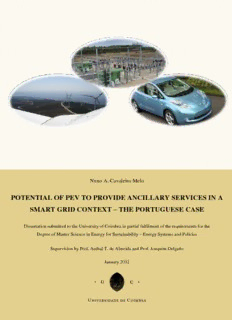
potential of pev to provide ancillary services in a smart grid context PDF
Preview potential of pev to provide ancillary services in a smart grid context
Nuno A. Cavaleiro Melo POTENTIAL OF PEV TO PROVIDE ANCILLARY SERVICES IN A SMART GRID CONTEXT – THE PORTUGUESE CASE Dissertation submitted to the University of Coimbra in partial fulfilment of the requirements for the Degree of Master Science in Energy for Sustainability – Energy Systems and Policies Supervision by Prof. Aníbal T. de Almeida and Prof. Joaquim Delgado January 2012 To my wife, Patrícia, and my lovely daughter, Beatriz, my energy sources! “Everyone needs to think differently about the future, a future that is riddled with change, challenge, and risk.” James Canton Acknowledgement First of all, I would like to thank to my supervisors at ISR – Institute of Systems and Robotics, Prof. Aníbal T. de Almeida and Prof. Joaquim Delgado, for their availability and support to develop this work. I would also like to thank to Eng. Francisco Mira and Eng. Garcia Monteiro, from EDP Distribuição, Prof. Carlos Henggeler Antunes, from INESC Coimbra, and Eng. Rui Pestana, from REN, for their precious technical support. I wish to thank to colleagues at ISR, Anabela Carvalho, Ana Cristina Lopes, Luis Conde, Pedro Moura and Ricardo Faria, to colleagues of the Energy for Sustainability Initiative, Ana Soares, Andreia Carreiro, Fernando Rodrigues and Marta Lopes, and to colleagues of work, António Lebre, Flávio Cação, Pedro Veloso and Teresa Couceiro for their collaboration and friendliness. I would also like to thank to my close family, António, Letícia, Alda, José Carlos and Diogo for their permanent support. And, I am thankful to Patrícia and Beatriz for their warmth and unconditional support. Abstract Regarding challenges of modern society on energy and climate fields, the increasing adoption of renewable energy sources seems to be the best approach to achieve a sustainable energy generation in a framework of increasing demand. On the other hand, the electric mobility is promising a new paradigm towards a more efficient and clean transportation sector. However, the intermittent renewable generation is challenging the operation of electric power systems, namely in terms of generation forecasting, system stability and quality of service, requiring the development of smarter grids and controllable loads. At this level, the charging process of Plug-in Electric Vehicles (PEV), associated to optimum control strategies, represents a new potential resource to provide ancillary services, contributing to the accommodation of higher shares of renewable generation on the electric power system. This work aims to contribute to the development of a cost-effective control system for efficient integration of PEV in the electric power system, taking the synergies between them. Therefore, the potential of PEV to contribute to the primary regulation, secondary regulation and regulation reserve in the Portuguese power system is analysed, regarding the commute profile by car in Portugal and the typical demand of PEV. On the other hand, in order to identify possible distribution network constraints to be considered on the development of the control system, the impact of PEV charging on Power Quality (PQ) is also analysed based on some field measurements. This work shows that a universe of 280 000 PEV has potential to provide an average secondary regulation reserve of 123 MW for up-regulation and 63 MW for down-regulation, during the night-time charging period, if supported in a dedicated control system. On the other hand, if energy required by PEV every night was used to provide regulation reserve for down- regulation, PEV would contribute with a share between 13% and 100% of the required regulation reserves by the electric power system during weeknights of January 2011, and with a share between 38% and 100% of the required reserves in September 2011. Regarding PQ, the monitoring results show maximum 3rd harmonic currents around 12% and Total Harmonic Distortion (THD) between 12% and 16%, which can contribute to increase the harmonic I distortion in Low Voltage (LV) public distribution networks, despite recorded harmonic current emissions being significantly below the limits established by current standards. Keywords PEV; secondary regulation, regulation reserve; renewable generation; smart grids
Description: